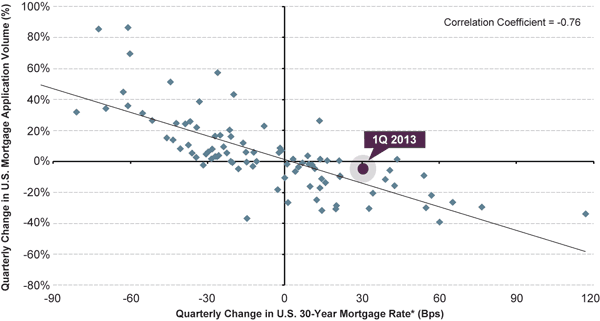The Fed's Dilemma
by Scott Minerd, CIO, Guggenheim Partners LLC
“Volatility is rising and asset prices are highly vulnerable to all incoming news. Recent sell-offs in stocks and bonds indicate that the current uptrend could uncoil before the end of quantitative easing (QE). The amount of attention paid to rumors about QE highlights how vulnerable the U.S. economy is to the prospect of a tapering in asset purchases or a rise in interest rates.
This is largely because the current economic expansion is dependent on further gains in housing, which would be adversely affected by a material rise in mortgage rates. Between one and two percent of GDP growth is coming from housing activity. The sluggishness in the rest of the economy is evident if you remove that number from the latest reading of 2.4 percent GDP growth for Q1. This dynamic underpins the Federal Reserve’s current dilemma over how to normalize monetary policy. I do not anticipate an easy ride for policymakers or investors over the coming months.”
Economic Data Releases
GDP Revision Ticks Down, While Consumer Confidence Surges
- First quarter GDP was revised down from 2.5% annualized growth to 2.4%. Positive consumer spending revisions were offset by slower inventories and steeper government spending cuts.
- The ISM manufacturing PMI fell below 50 for the first time in six months in May at 49.0.
- Personal income was flat in April, missing forecasts of 0.1% growth.
- Personal spending fell 0.2% in April, the first decrease in 11 months.
- Initial unemployment claims rose for the week ended May 25th to 354,000, while continuing claims stayed below the three million mark for a second straight week.
- University of Michigan consumer confidence was revised up in the final May estimate, rising to 84.5, the highest level since July 2007.
- The Chicago PMI jumped to 58.7 in May from 49 in April, the largest one-month increase in 30 years.
- The April trade deficit widened less than expected to -$41.1 billion. Exports were up 1.2% and imports rose 2.4%.
European Manufacturing Slows Pace of Contraction, Conflicting PMIs in China
- Eurozone manufacturing PMIs were revised upward in the final May estimate, though Germany, France, Italy, and the region in aggregate all remained in contraction.
- Eurozone unemployment continued to rise into record territory, ticking up to 12.2% in April.
- Eurozone economic confidence reversed two months of decreases, rising to 89.4 in May.
- The eurozone CPI rose in May to 1.4% after falling for four months.
- German retail sales had a third consecutive monthly decrease, falling 0.4% in April.
- The U.K. manufacturing PMI showed expansion in May, and April’s PMI was also revised to expansion.
- The HSBC China manufacturing PMI dipped into contraction in May at 49.6, the lowest reading since October 2012. The official PMI increased to 50.8.
- Japan’s industrial production increased 1.7% in April, higher than the forecast 0.6%.
- Japan’s monetary base grew 31.6% from a year earlier, the fastest annual growth since 2002.
Chart of the Week
Sensitivity of Housing Activity to Changing Rates
U.S. mortgage applications, a key indicator of housing activity, rose substantially over the past two years due to decreasing mortgage rates engineered by the Federal Reserve. However, since the start of 2013, mortgage rates have begun to climb as economic activity has picked up. As a result, mortgage applications in the first quarter were 5% lower than in the previous quarter. With rates continuing to climb substantially over the past month, there may be headwinds for mortgage applications and housing sales in the coming months.
QUARTERLY CHANGE IN MORTGAGE RATES AND MORTGAGE APPLICATIONS

Source: Bloomberg, Guggenheim Investments. Data as of 3/31/2013. *Note: The 30-year mortgage rate is the Fannie Mae 30-year fixed commitment rate.
This article is distributed for informational purposes only and should not be considered as investing advice or a recommendation of any particular security, strategy or investment product. This article contains opinions of the author but not necessarily those of Guggenheim Partners or its subsidiaries. The author’s opinions are subject to change without notice. Forward looking statements, estimates, and certain information contained herein are based upon proprietary and non-proprietary research and other sources. Information contained herein has been obtained from sources believed to be reliable, but are not assured as to accuracy. No part of this article may be reproduced in any form, or referred to in any other publication, without express written permission of Guggenheim Partners, LLC. ©2013, Guggenheim Partners. Past performance is not indicative of future results. There is neither representation nor warranty as to the current accuracy of, nor liability for, decisions based on such information.











